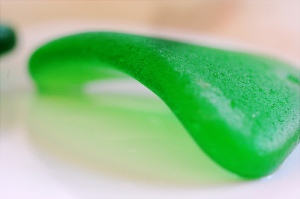No. I mentioned in the very first BCS blog entry that the horseshoe crab is a “sweetheart of an animal” and I will continue to defend that statement. Some people may think that the tail spine, or telson, is poisonous. What the telson is simply used for is to flip the animal over when a wave turns it onto its carapace. The tip of the telson is jabbed into the sand and the horseshoe crab rights itself over, somewhat like the act of throwing a javelin.
Do you have another great question? Check out www.beachchairscientist.com and let us know what you always ponder while digging your toes in the sand!
 that you find have spent a considerable amount of time floating in the ocean. It has been tumbling along the sand and water for so long that that the glass, slate or what have you, has been polished by the sand grains.
that you find have spent a considerable amount of time floating in the ocean. It has been tumbling along the sand and water for so long that that the glass, slate or what have you, has been polished by the sand grains.







What people are saying …